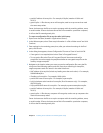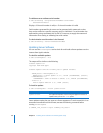
48 Chapter 3 Installing Server Software and Finishing Basic Setup
Changing Server Settings
After initial setup, you can use a variety of commands to view or change Mac OS X
Server configuration settings and services.
Using the serversetup Tool
The serversetup tool is located in /System/Library/ServerSetup. To run it, you can enter
the full path:
$ /System/Library/ServerSetup/serversetup -getAllPort
If you want to use the tool to perform several commands, you can change your
working folder and enter a shorter command:
$ cd /System/Library/ServerSetup
$ ./serversetup -getAllPort
$ ./serversetup -getDefaultInfo
Or, add the folder to your search path for this session and enter an even shorter
command:
$ PATH="$PATH:/System/Library/ServerSetup"
$ serversetup -getAllPort
To permanently add the folder to your search path, add the path to the file
/etc/profile.
Using the serveradmin Tool
The serveradmin tool is used for administering service-related tasks. Some services
need to be restarted after you change certain settings. If you make a change using a
service’s writeSettings tool that requires you to restart the service, the output from
the command includes the setting <svc>:needsRecycleOrRestart with a value of yes.
Important: The needsRecycleOrRestart setting is displayed only if you use the
serveradmin
svc
:command = writeSettings command to change settings. You won’t
see it if you use the serveradmin settings command.
Other chapters in this guide have information about using the serveradmin tool to
administer specific services.
Notes on Communication Security and the servermgrd Tool
When you run the serveradmin tool, you’re communicating with a local or remote
servermgrd process.
 servermgrd uses SSL for encryption and client authentication, but not for user
authentication. User authentication uses Open Directory services.
 servermgrd uses a self-signed (test) SSL certificate installed by default, located in
/etc/servermgrd/ssl.crt/. You can replace this with an actual certificate. You can use
the Certificate Manager in Server Admin to create and manage certificates. See the
mail service administration guide for more information.


















